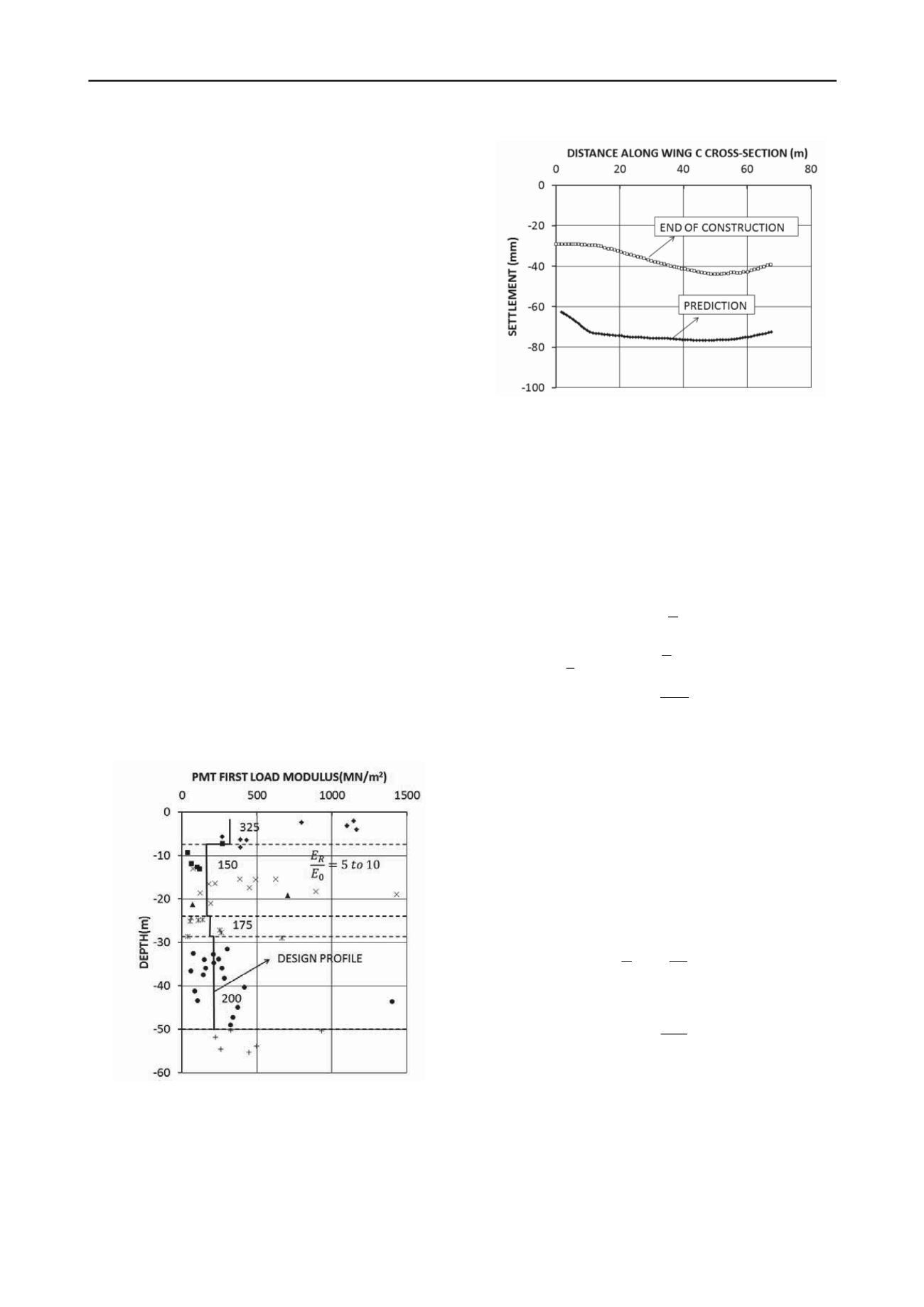
119
Honour Lectures /
Conférences honorifiques
Proceedings of the 18
th
International Conference on Soil Mechanics and Geotechnical Engineering, Paris 2013
In making settlement calculations for such structures, some
use the rules proposed by Menard and some use the elastic
equations often with an unload-reload modulus. Those who use
the Menard rules, use α values based on local experience and
influenced by the ratio between the unload-reload modulus E
r
and the first load modulus E
o
. While the value of the ratio E
o
/E
r
varies within a range somewhat similar to the range of α values,
it is not clear why one should be related to the other. The ratio
E
o
/E
r
is influenced by the development of plastic deformation
around the probe while the value of α is argued to be related to
the combination of lack of strength in tension (hoop direction as
shown in Section 7.1) and recompression process through an S
shape curve (Fig. 8). Those who use the elastic equation
together with an unload-reload modulus face the problem that
the unload reload modulus is ill defined and depends in
particular on the extent of the unloading and the stress level at
which the unloading takes place.
The case of the foundation of the tallest tower on Earth, the
828m high Burj Khalifa in Dubai, UAE, is studied further to
investigate the issue of the first load modulus and the reload
modulus (Poulos, 2009). The Burj Khalifa weighs
approximately 5000MN and has a foundation imprint of about
3300m
2
. The foundation is a combined pile raft 3.5 m thick
founded at a depth of about 10 m below ground level on 1.5 m
diameter bored piles extending some 50 m below the raft. To
predict the settlement of the tower, a number of methods were
used including numerical simulations. For these simulations a
modulus profile was selected from all soil data available
including 40 PMT tests. The PMT first load modulus profile is
shown in Fig. 20 along with the selected design profile as input
for settlement calculations by numerical simulations. As can be
seen the design profile splits the PMT first load modulus profile
with some conservatism. The settlement of the tower was
predicted to be 77mm; it was measured during construction and
reached 45 mm at the end of construction (Fig. 21). The
reasonable comparison between measured and predicted
settlement for this major case history gives an indication that it
is appropriate to use the PMT first load modulus for settlement
estimates.
Figure 20. First load PMT modulus profile and selected design
modulus values for the Burj Khalifa, Dubai, UAE (after Poulos,
2009)
Figure 21. Measured and predicted settlement of the Burj
Khalifa, Dubai, UAE (after Poulos, 2009)
10 DEEP FOUNDATIONS UNDER HORIZONTAL LOADS
10.1 Single pile behavior
For vertically loaded piles, it is common to calculate the
ultimate capacity of the pile due to soil failure and then the
settlement at working load. For horizontally loaded piles, an
ultimate load due to soil failure is not usually calculated. Briaud
(1997) proposed an equation to calculate the ultimate horizontal
load due to soil failure for a horizontally loaded pile.
1/4
3
4
3
3
4
4
2.3
v
o
v
o
ou
L v
p
o
o
o
D l
for L l
L D
for L l
H p BD
E I
l
K
K E
(50)
Where H
ou
is the horizontal load corresponding to a horizontal
displacement equal to 0.1B, B the pile diameter, p
L
the PMT
limit pressure, D
v
the depth corresponding to zero shear force
and maximum bending moment, l
o
the transfer length, L the pile
length, E
p
the modulus of the pile material, I the moment of
inertia of the pile around the bending axis, K the soil stiffness,
and E
o
the PMT first load modulus.
In order to expand that solution to create the entire load
displacement curve for horizontally loaded piles, it is proposed
to first use a strain compatibility equation such that the relative
displacement to reach the ultimate load on the pile (y/B = 0.1)
corresponds to the relative PMT expansion at the limit pressure
(∆R/R
o
= 0.41).
0.24
o
y
R
B R
(51)
Then the load on the pile can be transformed into a pressure
within the most contributing zone as
o
pile
v
H p
BD
(52)
The Γ value is the ratio of the pressure on the pile divided by
the pressure on the PMT for a corresponding set of values of
y/B and ∆R/R
o
which satisfy Eq. 51. That way and point by
point, the Γ function can be generated as a function of y/B or
0.24∆R/R
o
. This approach is consistent with the approach taken
for the load settlement curve method for shallow foundations.
This was done for 5 piles including driven and bored piles as
well as sand and clay soils. The piles are described in Briaud
(1997) and in Briaud et al. (1985). They ranged from 0.3 to 1.2
m in diameter and from 6 to 36 m in length. In each case, the
pile dimensions were known, the load displacement curve was


